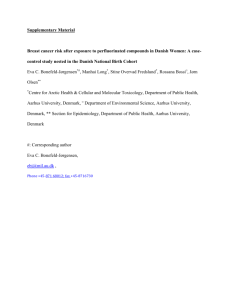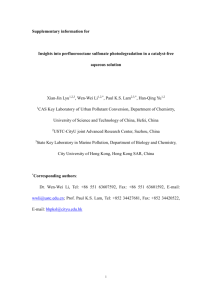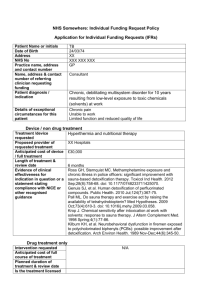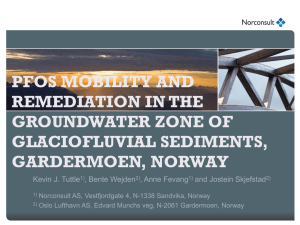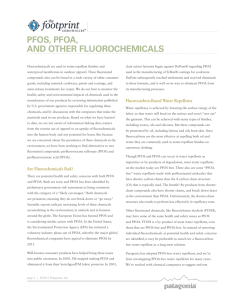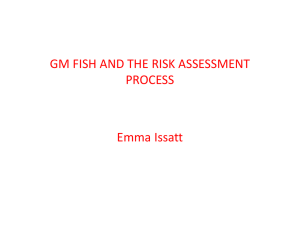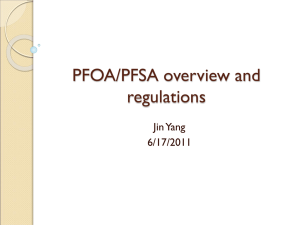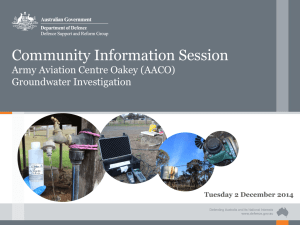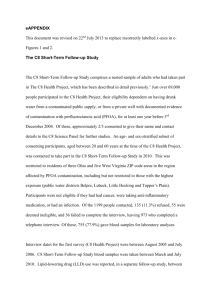Australia - Stockholm Convention on Persistent Organic Pollutants
advertisement
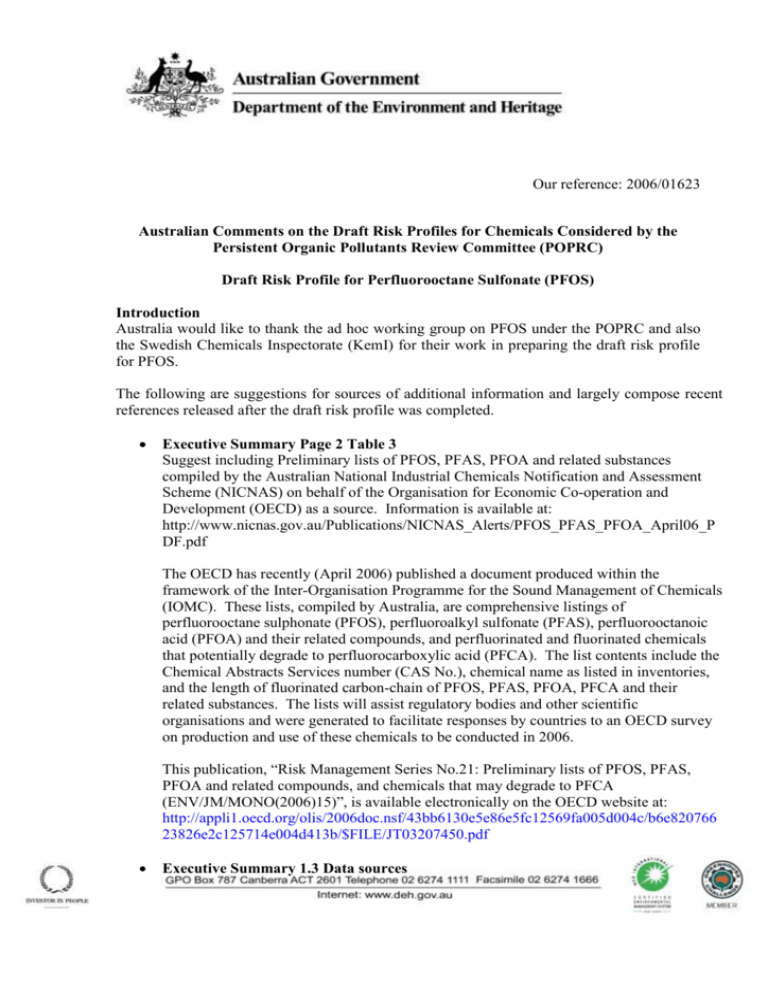
Our reference: 2006/01623 Australian Comments on the Draft Risk Profiles for Chemicals Considered by the Persistent Organic Pollutants Review Committee (POPRC) Draft Risk Profile for Perfluorooctane Sulfonate (PFOS) Introduction Australia would like to thank the ad hoc working group on PFOS under the POPRC and also the Swedish Chemicals Inspectorate (KemI) for their work in preparing the draft risk profile for PFOS. The following are suggestions for sources of additional information and largely compose recent references released after the draft risk profile was completed. Executive Summary Page 2 Table 3 Suggest including Preliminary lists of PFOS, PFAS, PFOA and related substances compiled by the Australian National Industrial Chemicals Notification and Assessment Scheme (NICNAS) on behalf of the Organisation for Economic Co-operation and Development (OECD) as a source. Information is available at: http://www.nicnas.gov.au/Publications/NICNAS_Alerts/PFOS_PFAS_PFOA_April06_P DF.pdf The OECD has recently (April 2006) published a document produced within the framework of the Inter-Organisation Programme for the Sound Management of Chemicals (IOMC). These lists, compiled by Australia, are comprehensive listings of perfluorooctane sulphonate (PFOS), perfluoroalkyl sulfonate (PFAS), perfluorooctanoic acid (PFOA) and their related compounds, and perfluorinated and fluorinated chemicals that potentially degrade to perfluorocarboxylic acid (PFCA). The list contents include the Chemical Abstracts Services number (CAS No.), chemical name as listed in inventories, and the length of fluorinated carbon-chain of PFOS, PFAS, PFOA, PFCA and their related substances. The lists will assist regulatory bodies and other scientific organisations and were generated to facilitate responses by countries to an OECD survey on production and use of these chemicals to be conducted in 2006. This publication, “Risk Management Series No.21: Preliminary lists of PFOS, PFAS, PFOA and related compounds, and chemicals that may degrade to PFCA (ENV/JM/MONO(2006)15)”, is available electronically on the OECD website at: http://appli1.oecd.org/olis/2006doc.nsf/43bb6130e5e86e5fc12569fa005d004c/b6e820766 23826e2c125714e004d413b/$FILE/JT03207450.pdf Executive Summary 1.3 Data sources 2 Suggest also including the most recent US Environmental Protection EPA risk assessment of PFOA and its salts as well as the recent Science Advisory Board (SAB) Review findings, if US EPA will allow them to be cited as a data source: US EPA (2005) Draft Risk Assessment of the Potential Human Health Effects Associated with Exposure to Perfluorooctanoic Acid and Its Salts. U.S Environmental Protection Agency, Office of Pollution Prevention and Toxics, Risk Assessment Division, January 4 2005 available at: http://www.epa.gov/opptintr/pfoa/pfoarisk.pdf US EPA Science Advisory Board (SAB) Review of the EPA's Draft Risk Assessment of Potential Human Health Effects Associated with PFOA and It's Salts. Office of the Administrator, Science Advisory Board, May 30 2006 available at: http://www.epa.gov/sab/pdf/sab_06_006.pdf Executive Summary 1.4 Summary of Available Risk Information The paragraph mentioning the Canadian Environmental Screening Assessment Report on PFOS, Its Salts and Precursors does not mention that PFOS and its salts was proposed as a candidate for virtual elimination under the Canadian Environmental Protection Act 1999 (CEPA). The assessment report is available at: http://www.ec.gc.ca/CEPARegistry/documents/subs_list/PFOS/EC_SAR__PFOS_October_2_2004_e.pdf The section detailing US EPA action to date does not mention either the most recent US EPA risk assessment of PFOA and Its Salts, its subsequent Science Advisory Board (SAB) Review findings or the US EPA voluntary Global PFOA Stewardship Program launched on 25/1/06, which invites companies to reduce PFOA releases and its presence in products by 95% by no later than 2010 and to work toward eliminating sources of exposure five years after that but no later than 2015. Information available at: http://www.epa.gov/oppt/pfoa/pfoastewardship.htm Section 2.1.1 Production, trade and stockpiles Suggest that the production/trade data may need updating with more recent figures and producers. The US EPA Global Stewardship Program launched on January 25 2006, includes the following international companies: 1. 3M / Dyneon 2. Arkema, Inc. 3. AGC Chemicals / Asahi Glass 4. Ciba Specialty Chemicals 5. Clariant Corporation 6. Daikin 7. E. I. DuPont de Nemours and Company 8. Solvay Solexis. All of the above companies are manufacturers or users of fluoropolymer products and have committed to the program. The Committee should check if these companies also use the same production processes outlined by 3M. Section 2.1.2 Uses 3 A number of these companies have US manufacturing facilities producing perfluorinated chemicals, particularly DuPont. Analysts at J P Morgan have estimated that DuPont’s PFOA-related product lines, fluoropolymers and telomers products, contribute about $1.23 billion to 2003 sales and $100 million to profit. DuPont’s earnings in 2003 were $973 million on revenue of $27 billion – thus these products contributed approximately 10% of DuPont’s annual profit. One of DuPont’s most recent quarterly reports to the SEC discusses possible regulation or prohibition of PFOA products. It states that “products currently manufactured by the company representing approximately $1 billion of 2004 revenues could be affected by any such regulation or prohibition”. When discussing PFOS, it is important to note whether PFOS specifically is meant, or the broader family of related substances. While PFOS may have been phased out, PFOA and other perfluorochemicals may still be in production and use. Much of the uses section relies on data from 3M and does not mention subsequent takeover and expansion into fluorochemistry by companies including DuPont following 3M’s exit from this market. The DEFRA Risk Reduction Strategy for PFOS lists alternatives for metal plating, fire fighting foams, photographic, photolithographic and semiconductor industries and use in aviation hydraulic fluid uses. Some uses have effective alternatives whilst others currently don’t. The report assumes that other historical uses such as carpets, leather/apparel, textiles/upholstery, paper and packaging, coatings and coating additives, industrial and household cleaning products and pesticides and insecticides have ceased within the UK. This supposition cannot necessarily be made for other markets including the US and Australian markets. Section 2.1.3 Releases to the Environment There has been a lot of research recently conducted in this area including a large European (1,104,500 Euro) joint project called PERFORCE (PERFluorinated ORganic Chemicals in the European environment) researching how PFC’s get into the environment, how they move within and between different environmental compartments and their key environmental properties. This research is led by the University of Amsterdam and has Norwegian, Swedish and Belgian partners as well as representatives from DuPont. It has EU funding of 790,000 Euro under the 6th Framework Programme. Informative recently published articles include: 1. Significant Residual Fluorinated Alcohols Present in Various Fluorinated Materials Dinglasan-Panlilio, M.J.A. and Mabury, S.A. Environ. Sci. Technol., 40, 5, 1447 - 1453, 2006, 10.1021/es051619+ 2. Mass Loading and Fate of Perfluoroalkyl Surfactants in Wastewater Treatment Plants Sinclair, E. and Kannan, K. Environ. Sci. Technol., 40, 5, 1408 - 1414, 2006, 10.1021/es051798v 3. Formation of C7F15COOH (PFOA) and Other Perfluorocarboxylic Acids during the Atmospheric Oxidation of 8:2 Fluorotelomer Alcohol Wallington, T.J., Hurley, M.D., Xia, J., Wuebbles, D.J., Sillman, S., Ito, A., Penner, J.E., Ellis, D.A., Martin, J., Mabury, S.A., Nielsen, O.J., and SulbaekAndersen, M.P. Environ. Sci. Technol., 40, 3, 924 - 930, 2006, 10.1021/es051858x Reference to U.S Releases Estimation 1997 doesn’t seem to be fully referenced in the References section of the risk profile and needs to be provided. 4 Long Range Environmental Transport Recent research conducted in this area includes the publications mentioned above and the following: 1. The Partition Behavior of Fluorotelomer Alcohols and Olefins Goss, K.-U., Bronner, G., Harner, T., Hertel, M., and Schmidt, T.C. Environ. Sci. Technol., 40, 11, 3572 - 3577, 2006, 10.1021/es060004p Exposure – Measured Environmental Levels The section detailing US environmental exposure to perfluorochemicals should also include the following: 1. 3M faces lawsuits due to alleged perfluorochemical contamination in Minnesota from their Cottage Grove facility as well as from its Decatur, Alabama facility. Minnesota Pollution Control Agency scientists have collected blood samples from fish in the Mississippi River showing very high levels of PFOS. The results were apparently “10 times higher than had been reported anywhere for fish or wildlife”. See Reference: Investigation Of Perfluorochemical (PFC) Contamination In Minnesota Phase One - Report to Senate Environment Committee at: http://www.peer.org/docs/mn/06_27_2_pfc_report.pdf 2. DuPont facilities at Fayetteville, North Carolina; Circleville, Ohio; and Washington, West Virginia are also sources of environmental exposure to perfluorinated chemicals. Health testing of Ohio and West Virginia residents is in progress as a result of the $343 million dollar settlement of a class action lawsuit alleging chemical contamination of drinking water. Section 2.3.1 Bioavailability Australia questions whether PFOS is in fact mainly released to the environment through water from sewage treatment plants given recent research mentioned above concerning long-range transport of fluorinated alcohols. Australia suggests mentioning specifically that PFOS has recently been detected in the blood serum of the general population. International and Australian references include: 1. OECD Hazard Assessment of PFOS 2002 p17 http://www.oecd.org/dataoecd/23/18/2382880.pdf 2. Perfluorochemicals in Pooled Serum Samples from United States Residents in 2001 and 2002 Calafat, A.M., Kuklenyik, Z., Caudill, S.P., Reidy, J.A., and Needham, L.L. Environ. Sci. Technol., 40, 7, 2128 - 2134, 2006, 10.1021/es0517973 http://pubs.acs.org/cgi-bin/abstract.cgi/esthag/asap/abs/es0517973.html 3. Isomer Distribution of Perfluorocarboxylates in Human Blood: Potential Correlation to Source DeSilva, A.O. and Mabury, S.A. Environ. Sci. Technol., 40, 9, 2903 - 2909, 2006, 10.1021/es0600330 4. Perfluorinated Compounds In Serum From Australian Urban And Rural Regions. Organohalogen Compounds, vol 67, p 780-783. (Also published in Environ. Sci. Technol below) 5. Levels of 12 Perfluorinated Chemicals in Pooled Australian Serum, Collected 2002-2003, in Relation to Age, Gender, and Region 5 Karrman, A., Mueller, J.F., vanBavel, B., Harden, F., Toms, L.-M.L., and Lindstrom, G. Environ. Sci. Technol., 40, 12, 3742 - 3748, 2006, 10.1021/es060301u 6. Biological Monitoring of Polyfluoroalkyl Substances: A Review Houde, M., Martin, J.W., Letcher, R.J., Solomon, K.R., and Muir, D.C.G. Environ. Sci. Technol., 40, 11, 3463 - 3473, 2006, 10.1021/es052580b In regards to worker exposure levels, the Committee should also probably check blood serum levels in DuPont workers contaminated over many years of exposure. Levels could be comparable to 3M worker exposure levels. Advocacy groups have recently found PFOS and PFOA in household dust in composite samples from seven US states. Reference: Sick of Dust - Chemicals In Common Products — A Needless Health Risk In Our Homes. Clean Production Action March 2005 http://www.saferproducts.org/downloads/Dust%20Report.pdf Section 2.4.1 Toxicity Include most recent US EPA Science Advisory Board findings if agreed to by US EPA. Concluding Statement There is currently some uncertainty as to whether the voluntary phase out of PFOS production by 3M “has led to a significant reduction in the current use of PFOS-related substances”. This could be clarified by requesting current production data from the companies still producing perfluorinated chemicals mentioned above. This information has probably already been made available to the US EPA through the recently launched US EPA Global Stewardship Program. Continued use of perfluorochemicals has been demonstrated through the following recent publication: OECD (2005) Results Of Survey On Production And Use Of PFOS, PFAS And PFOA, Related Substances And Products/ Mixtures Containing These Substances, January 2005. http://www.olis.oecd.org/olis/2005doc.nsf/43bb6130e5e86e5fc12569fa005d004c/ 9dccc1c0ae173bbdc1256f88005917c6/$FILE/JT00176885.PDF This survey is currently being repeated with 2006 data.

